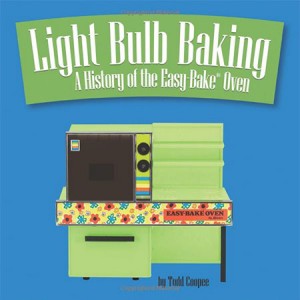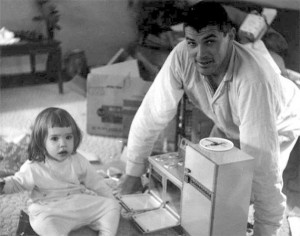Book marks 50th aniversary of the Easy Bake Oven
Earlier this month Dale Hobson wrote about the National Toy Hall of Fame, including this year’s nominees. Judging from the response, many classic toys and games have staying power, in our minds if not in terms of sales at Christmas this year. (Note: the inductees for 2013 were yellow rubber duck and chess.)

Find this book online at Amazon or Barnes and Noble. Or buy it through your local bookseller.
Here’s a follow-up about a Hall of Fame inductee from 2006, the Easy Bake Oven. Just in time for its 50th anniversary Ottawa author Todd Coopee has produced a book with pretty much everything you might want to know on the subject: Light Bulb Baking: a History of the Easy Bake Oven.
As reported by Bruce Deachman for the Ottawa Citizen, Coopee grew up in Easthampton, Massachussets, the youngest of five children. His parents owned and ran a restaurant. Food, cooking and kitchen management came naturally:
“I enjoyed doing things with my sisters,” says Coopee. And although the ovens were primarily used then by girls, he notes that even from its first days in 1963, the toy was marketed to both boys and girls, the photos on the packaging always showing at least one of each. Kenner later came out with a popcorn-making attachment that it marketed almost exclusively to boys, and, after Hasbro bought Kenner, a version of the oven was released that was also aimed at the audience made of snakes and snails and puppy-dog tails: The Queasy Bake Cookerator, which Coopee notes fared poorly.
Today, Coopee runs Studio 91 in Ottawa, which isn’t a night club but a web communications shop.
I never had an Easy Bake Oven and I’m not even sure why. Probably it was on the expensive side. What I seem to remember was rejecting the concept as completely unacceptable. You have to wait how long for a dinky little cake that small?!? Please! Just bake a real cake and have plenty! (I’m better now, but patience was not my strong suit as a child.)
I was suckered into saving for a long time to buy another expensive toy, “Incredible Edibles,” another bake and eat thing, where you squeezed goo into molds of different shapes. When cooked they looked like insects, or what not. All of which could be eaten in a flash. The goo was short-lived and expensive. I actually sat down and wrote a grumpy letter (I might have been 8 or so) to the manufacturer about my dashed hopes. Which I promptly forgot.
To my shock, weeks later I got a big box in the mail – full of more goo, all courtesy of Mattel! A nice gesture. My brothers and I quickly ate through the windfall and that was pretty much the end of that. Maybe the Easy Bake Oven would have been a better toy after all?

Father and daughter with early Easy Bake Oven, which resembled a conventional oven. Public domain
There’s an excerpt of Coopee’s book in the Toronto Star:
The team would have also worked together to overcome a key challenge with the idea of a toy oven: convincing parents that it was safe for their kids to use. To ease those concerns, a common incandescent light bulb was selected as the energy source rather than a traditional heating element, like what you would find in a toaster oven. Talk about brilliant thinking! Although the toy oven could become as hot as a conventional oven, the fact that a potentially hazardous cooking element was replaced by a common household object that kids were around every day — a light bulb — made the Easy-Bake oven appear virtually harmless.
The Star went all out with a supplemental article by Corey Mintz: “Easy-Bake cooking: the hardest part is opening the door,” from which I learned this:
Over the last decade, the 100-watt bulb has been phased out, replaced by a heating coil. Though some of my friends have a childhood memory of an Easy-Bake oven with a working door that opened, that’s a manufactured memory. The closest was a 2006 front-loading model, which resulted in hundreds of burnt fingers and a recall of nearly one million units.
Toys and holidays, the stuff of memories! But for this week’s heavy-duty food production, it’s best to stick with a real oven.
Tags: books, canada, Easy Bake Oven, history, Todd Coopee, toys








Mine surely was pink. It came with a packet of mix, which burned in the middle and stayed gooey at the edges when you mixed it with water and put the pan in the oven. Can’t remember whether the attempt to use it was made more than once but it was exciting to think that a lightbulb could bake a cake, even if it really couldn’t.